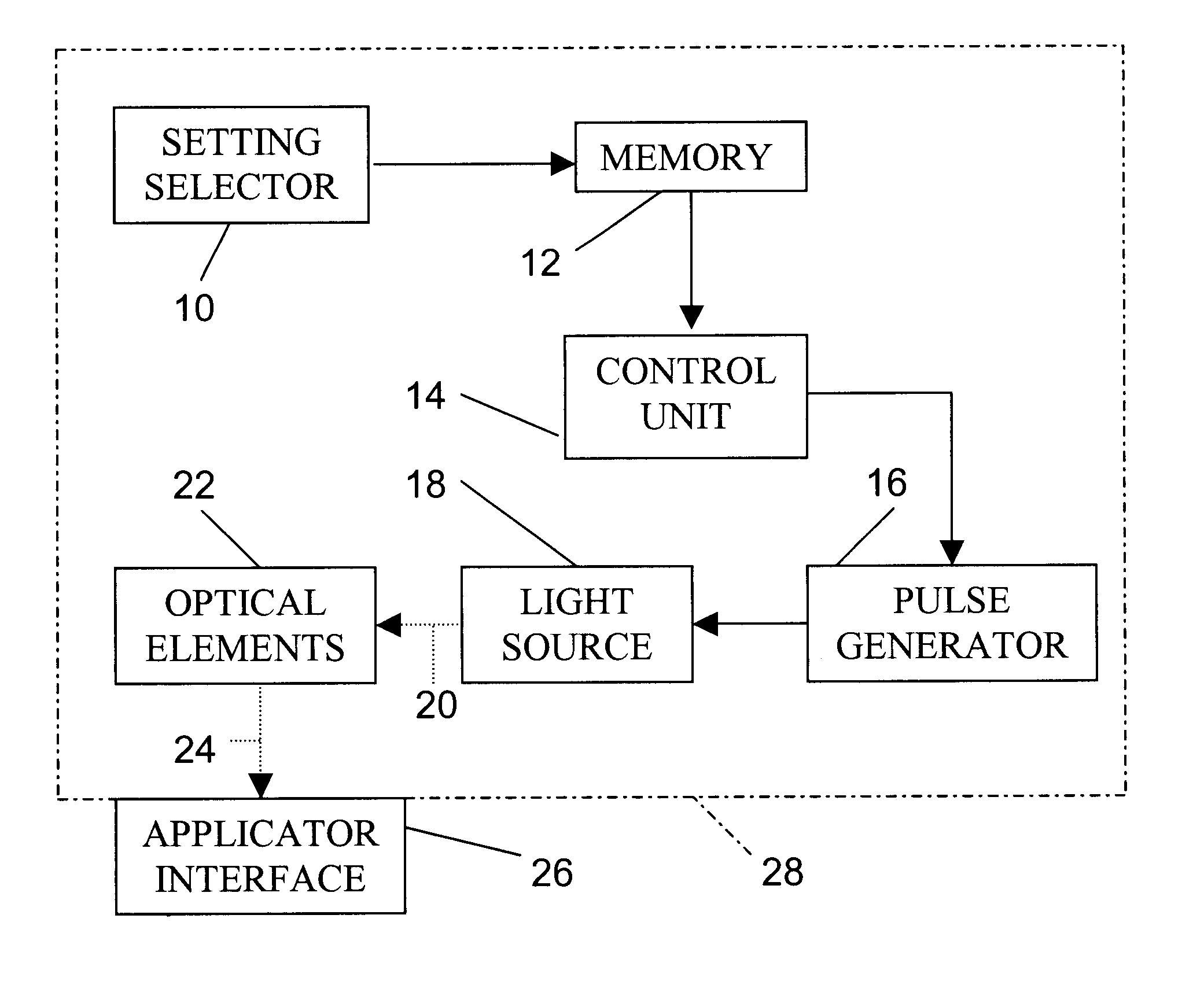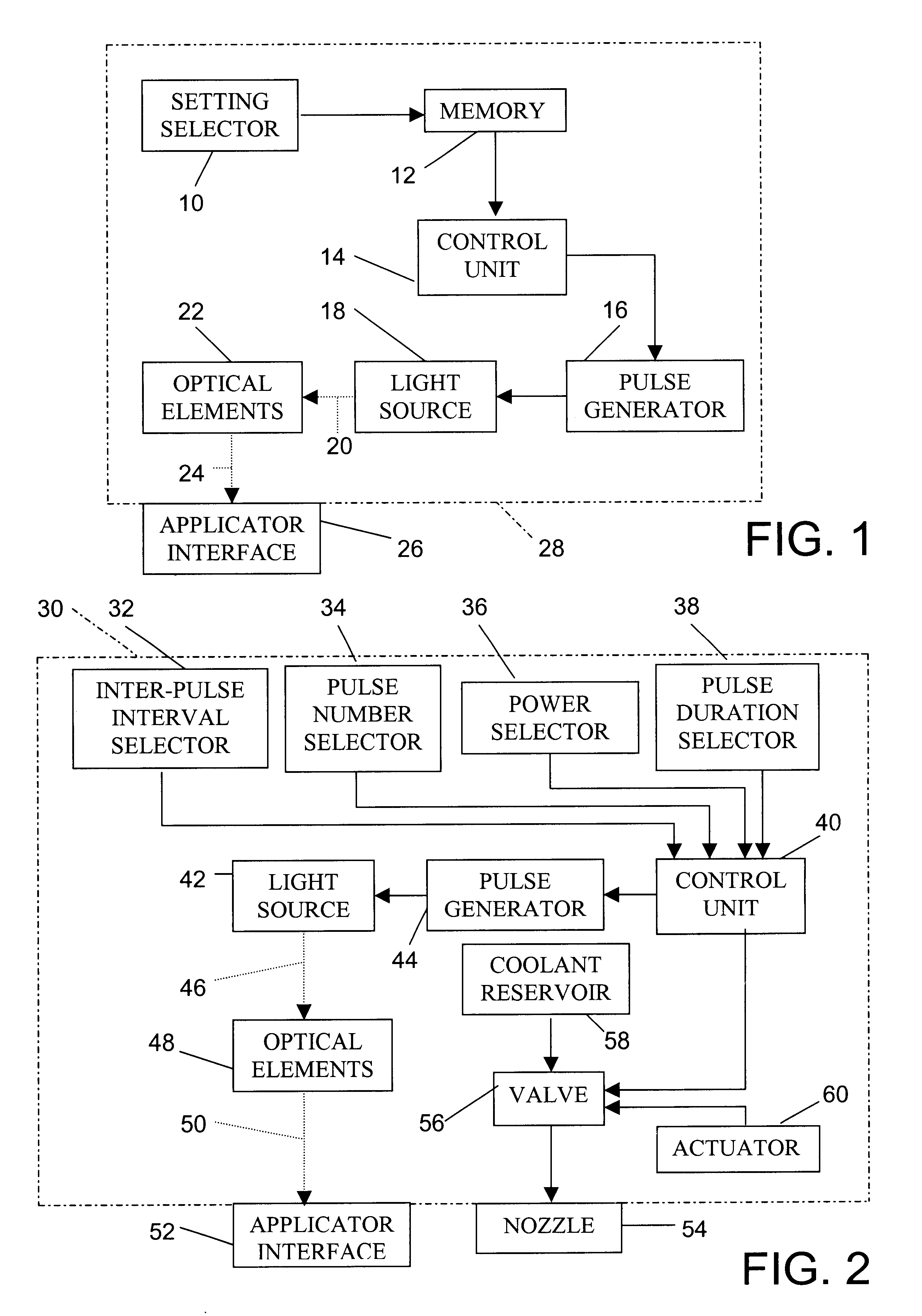Temporary hair removal method
a hair removal and temporary technology, applied in the field of temporary hair removal, can solve the problems of consuming public with few options for removing undesired hair, methods that carry a certain amount of risk of skin damage, and shortwavelengths less than 550 nm are not useful, so as to prevent excessive energy delivery, safe for home use, and energy consumption sufficient
- Summary
- Abstract
- Description
- Claims
- Application Information
AI Technical Summary
Benefits of technology
Problems solved by technology
Method used
Image
Examples
use example 5
Home In a low setting or combination of operational parameters, an incoherent light applicator device produces pulses with a pulse number of two, a pulse duration of 5 msec, an inter-pulse interval of 350 msec, a total pulse energy of 15 J / cm.sup.2, and a spectral distribution of a commercially available flashlamp, including wavelengths between 500 and 1200 nm. The pulse sequence of this example delivers a small amount of energy, at a low rate (e.g., long inter-pulse interval).
Home Use Example 6. A slightly higher setting or combination of operational parameters for an incoherent light applicator device involves pulses with a pulse number of two, a pulse duration of 5 msec, an inter-pulse interval of 300 msec, a total pulse energy of 20 J / cm.sup.2, and a spectral distribution of a commercially available flashlamp, including wavelengths between 500 and 1200 nm.
Home. Use Example 7. A lower setting or combination of operational parameters for an incoherent light applicator device invo...
use example 8
Home Another setting or combination of operational parameters for an incoherent light applicator device involves pulses with a pulse number of two, a pulse duration of 7 msec, an inter-pulse interval of 250 msec, a total pulse energy of 20 J / cm.sup.2, and a spectral distribution of a commercially available flashlamp, including wavelengths between 500 and 1200 nm.
The devices of FIGS. 1 and 2 may be provided with a band-pass filter for limiting the spectral distribution of the generated light pulses to wavelengths in a given band, for instance, between 700 nm and 900 nm. Alternatively, a low-pass filter may be used for transmitting to a skin surface only wavelengths less than a predetermined maximum, such as 900 nm, 750 nm, or 550 nm. The lower the wavelength the less likely the light will penetrate deeply and damage cellular and histological elements as deep as the bulb parts of the hair follicles. Shorter wavelengths, for instance, below 550 nm are useful for limiting the depth of ...
use example 2
Professional A slightly higher setting or combination of operational parameters for an incoherent light applicator device involves pulses with a pulse number of two, a pulse duration of 7 msec, an inter-pulse interval of 100 msec, a total pulse energy of 60 J / cm.sup.2, and a spectral distribution of a commercially available flashlamp, including wavelengths between 500 and 1200 nm.
PUM
 Login to View More
Login to View More Abstract
Description
Claims
Application Information
 Login to View More
Login to View More - R&D
- Intellectual Property
- Life Sciences
- Materials
- Tech Scout
- Unparalleled Data Quality
- Higher Quality Content
- 60% Fewer Hallucinations
Browse by: Latest US Patents, China's latest patents, Technical Efficacy Thesaurus, Application Domain, Technology Topic, Popular Technical Reports.
© 2025 PatSnap. All rights reserved.Legal|Privacy policy|Modern Slavery Act Transparency Statement|Sitemap|About US| Contact US: help@patsnap.com


